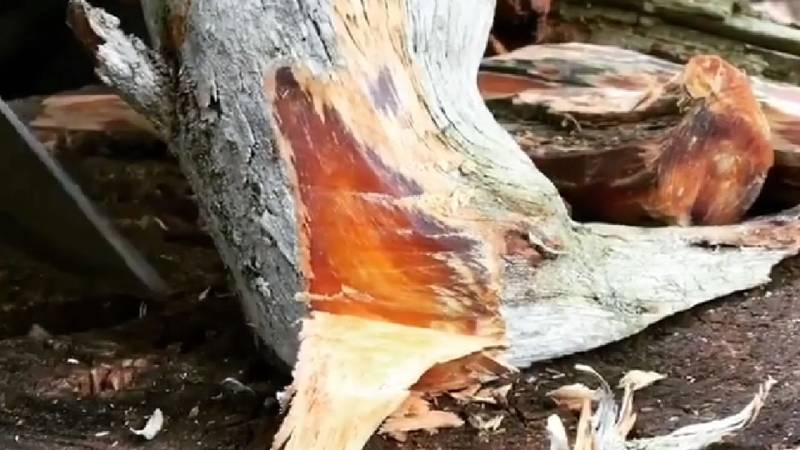
Fatwood
Substantiv/Nomen
Meaning
Fatwood is a highly valuable natural resource for survivalists, bushcraft enthusiasts, and outdoor adventurers. It refers to the resin-rich heartwood found in the stumps of pine trees, which is extremely flammable and can be used as an excellent fire starter. Fatwood is renowned for its high resin content, making it easy to ignite even in wet conditions. It is a reliable and efficient fire-starting material, providing a long-lasting flame that can be used for cooking, warmth, and signaling. Its lightweight and compact nature make it an essential item to carry in any outdoor kit, ensuring the ability to start a fire quickly and efficiently.

Examples
„I love using fatwood to start my campfire. It's so easy to light and burns for a long time.“
„When I went camping with my friends, I showed them how to find fatwood in the forest. They were amazed at how resin-rich it was and how well it worked as a fire starter.“
„During my survival training, I learned that fatwood is an essential resource in the wilderness. It's a reliable source of fire, especially when other tinder materials are scarce.“
„I always carry a small container of fatwood shavings in my backpack. They come in handy when I need to start a fire quickly, especially in wet conditions.“
„I recently discovered that fatwood can also be used as a natural insect repellent. The resin has a strong scent that keeps bugs away, making it a useful tool in the outdoors.“
Origin
The word "fatwood" originates from the United States, specifically from the southern regions such as the Appalachian Mountains. It is derived from the combination of the words "fat" and "wood".
Fatwood refers to the resin-rich heartwood found in the stumps and roots of pine trees. This wood is saturated with resin, making it highly flammable and ideal for starting fires in survival situations.
The use of fatwood can be traced back to Native American tribes who discovered its fire-starting properties. They would collect the resin-rich wood from fallen pine trees and use it as a reliable source of fire in their daily lives.
Over time, fatwood has become a popular term among outdoor enthusiasts, bushcrafters, and survivalists. It has gained recognition for its effectiveness in starting fires, even in damp or unfavorable conditions.
Today, fatwood is widely available in the form of kindling sticks, fire starters, or as natural pieces of resin-rich wood. It has become an essential item in many survival kits and camping gear, providing a reliable and efficient way to ignite fires in the wilderness.
Historical and cultural importance
Fatwood, also known as "fat lighter" or "lighter wood," has a rich historical and cultural significance in the world of survival and bushcraft. It refers to the resin-rich heartwood of pine trees, which is highly flammable and has been used for centuries as a reliable source of fire in various cultures.
In Native American cultures, fatwood was valued for its ability to easily ignite and sustain a fire, making it an essential tool for survival in the wilderness. It was often used in fire-starting techniques such as the bow drill or hand drill, where friction is used to create an ember that can ignite a fire. The resinous nature of fatwood made it an ideal tinder material, ensuring that fires could be started even in damp or unfavorable conditions.
Throughout history, fatwood has also been used by pioneers, explorers, and woodsmen as a reliable fire starter. Its high resin content and natural waterproofing properties made it a valuable resource for lighting fires in challenging environments, such as during wet or cold weather.
Today, fatwood continues to be highly regarded in the survival and bushcraft community. It is often sought after as a natural fire starter, especially by those who practice primitive fire-making techniques or enjoy spending time in the great outdoors. Its historical and cultural significance serves as a reminder of the importance of fire in human survival and the ingenuity of our ancestors in harnessing the resources of the natural world.
More information about the term Fatwood
What is Fatwood?
Fatwood, also known as lighter wood or pine knot, is a highly flammable and resin-rich wood that is commonly found in the heartwood of pine trees. It is formed when the tree undergoes a natural process of decay or when it is injured, causing the resin to accumulate in the wood. Fatwood is known for its exceptional fire-starting properties, making it a valuable resource for survivalists, campers, and outdoor enthusiasts.
How to Identify Fatwood
Identifying fatwood is relatively easy once you know what to look for. The wood has a distinct reddish-brown color and is often denser and heavier than regular pine wood. It has a strong, pleasant aroma due to the high concentration of resin. When you break a piece of fatwood, you will notice the resin-saturated fibers, which are highly flammable and can be easily ignited with a spark or flame.
Uses of Fatwood in Survival Situations
When it comes to survival situations, fatwood is an invaluable resource. Here are some of its uses:
Fire Starting: Fatwood is one of the best natural fire starters available. Its high resin content makes it highly flammable, even when wet. By shaving off some fatwood and using a fire starter or a spark from a ferro rod, you can easily ignite a fire, providing warmth, light, and a means to cook food.
Emergency Signaling: The resin-rich wood produces thick, black smoke when burned, making it an excellent choice for emergency signaling. By creating a smoky fire with fatwood, you can attract attention and increase your chances of being rescued.
Waterproofing: The resin in fatwood has natural waterproofing properties. By using shavings or small pieces of fatwood, you can create a waterproof tinder bundle, which can be crucial in wet or damp conditions.
Tool Handle: Fatwood is known for its durability and strength. In survival situations, it can be used to craft tool handles, such as knives or spears, providing a sturdy grip and enhancing your chances of success in hunting or self-defense.
Harvesting Fatwood
While fatwood can be found in the heartwood of various pine species, the easiest way to harvest it is by locating fallen or dead pine trees. Look for trees that have been on the ground for some time, as the decay process helps concentrate the resin in the wood. Use a knife or an axe to remove the outer layers of the wood until you reach the resin-rich core. Collect the fatwood shavings or small pieces and store them in a waterproof container for future use.
Remember to always practice responsible harvesting and avoid damaging live trees or protected areas.
Conclusion
Fatwood is a valuable resource in survival situations due to its exceptional fire-starting properties. Its high resin content and natural waterproofing abilities make it an essential tool for outdoor enthusiasts. By knowing how to identify and harvest fatwood, you can ensure that you have a reliable fire starter and versatile resource in your survival kit.
Back to overview

